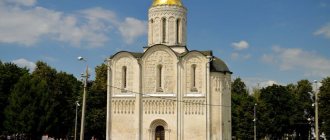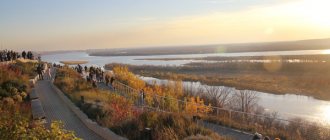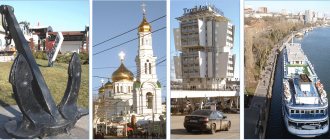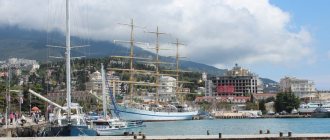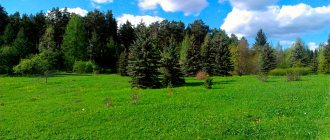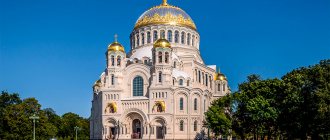Yakut records
The Republic of Sakha is the largest federal subject of our country. It covers an area of more than 3 million square meters. km, covers three time zones and extends from north to south for 2000 km, and from west to east for 2500 km.
Less than 1 million people live on the vast territory, so the population density is one of the lowest in the country - only 0.31 people per 1 square meter. km.
Spaso-Preobrazhensky City-Yakut Cathedral in Yakutsk
Yakutia is washed by cold seas and is located in a zone of sharply continental climate. From six to eight months there are frosts here, and the temperature often drops below -50°C. This is one of the coldest regions of Russia.
In 1938, a temperature of -77.8°C was recorded in Oymyakon. It is curious that in the same village in July 2010, +34.6°C was recorded. Thus, the temperature difference in one locality exceeded 100°. The air over Yakutia is dry and there is little precipitation. The height of the snow cover reaches only 15-25 cm.
Quarry "Mir"
Thanks to the rich mineral resources, industry is developed in the republic. There are no ordinary mines - the permafrost zone is too large. No matter how deep you go into the soil, you end up on a layer of frozen earth. In harsh lands there are deposits that are developed using open and semi-open methods. the Mir quarry remains one of the most famous.
, uranium, gold, oil, gas and coal. In addition, local residents - Yakuts, Russians, Evenks and Evenks - are engaged in woodworking, agriculture, deer breeding, hunting and fishing.
Chekurov cheeks
Chekurovsky cheeks are rocks on the Lena coast, formed by spurs of the Verkhoyansk Range. At this point, the width of the river bed drops to 2 km, and rocky ledges up to 400 meters high hang over the water. Chekurovsky cheeks consist of three rocky ledges: the left bank, the right bank and the Ponomarev pad. Chekurovsky cheeks are rightfully considered one of the most dangerous places for ships along the entire length of the river. Therefore, a semaphore mast is installed here, and a signalman regulates the passage of ships in this dangerous place.
Transport problem
Buluus Glacier
According to statistics, there are few tourists in Yakutsk. The reason for this is the expensive road. The Russian capital and the main city of Yakutia are separated by more than 8,000 km. The plane covers this distance in 6.5 hours, and the flight is not cheap.
To other Yakut cities - Oymyakon or Mirny, there are only river routes and winter roads. It turns out that getting to remote corners of the republic is possible only in the cold season and by water. Some travelers use local aviation - planes and helicopters, but the cost of such flights is also quite high.
Mount Harama
Mount Harama Hayata, located in the Amginsky ulus, became famous for the unusual image that can be seen on its slope. The naked eye can see the girl’s face, composed of crumbling rocks. It is believed that the Mistress of the Mountain is depicted here. According to legend, in ancient times, a battle took place near the mountainside between a shaman and an udaganka (priestess). The Udaganka won and it was her face that was displayed on the mountainside. Harama is considered a place of exceptional energy power, and therefore is popular among tourists and lovers of esotericism.
Cruises on the Lena
View of the Lena Pillars from the Lena River
There are more than a dozen hotels, hostels and mini-hotels in Yakutsk. Almost all of them are designed for business travelers who fly here on business. However, there are always rooms available for tourists.
River travel on motor ships along the Lena River is popular among visitors to Yakutia. They are carried out during the navigation period - from late July to early November.
Tourists travel both north and south from Yakutsk, and always spend the night on board the ship.
A trip of several days allows you to visit different natural areas - from the tundra to the taiga, see many sights, learn about the traditions, faith and life of indigenous peoples. Tourists are shown the sites of the most famous archaeological excavations and interesting natural monuments.
Tuculana Dunes
The small population of Yakutia has a unique culture that dates back many thousands of years. People lived on these lands long before they were discovered by Russian Cossacks. Archaeologists have found human sites on the territory of the republic ranging in age from 300 thousand to 10 thousand years. Especially many prehistoric settlements were discovered in the middle reaches of the Lena River.
The Evenks appeared in Yakutia quite late, in the middle of the 1st millennium AD. Later they mixed with the Paleo-Asian clans who had lived here for a long time, and a new nation was formed - the Yakuts.
A river trip along the Lena lasts from 12 to 14 days. During the summer season there are from 3 to 5 such cruises, so you should book your seats in advance.
Mount Kisilyakh
Mount Kisilyakh is a rock complex located in the Verkhoyansk ulus of Yakutia. As a result of the influence of the wind, the rock pillars on the top of the mountain formed into a unique shape, reminiscent of a group of people and animals. Despite the external similarity with Stonehenge, Kisilyakh is of exclusively natural origin. Translated from Yakut, the name of the mountain means “stone people”. This place has long been considered sacred among the Yakuts, and among fans of esoteric beliefs, Kisilyakh received the nickname “northern Shambhala.” Like most other natural sites in Yakutia, Kisilyakh is a difficult place to reach: you can only get here by helicopter or all-terrain vehicle.
"Lena Pillars"
Lena Pillars from a bird's eye view
This is the name of a large natural park located on the banks of the Lena, 104 km from the city of Pokrovsk and 200 km from Yakutsk. The height of the coastal limestone cliffs reaches 220 m. Bizarre stone giants resemble huge organs, slender towers, magical temples and medieval castles.
The territory of the natural reserve is home to animals of taiga forests and mountain taiga terrain - bears, moose, chipmunks, squirrels, ermines, sables, wild reindeer and musk deer. More than a hundred species of birds nest in the forests. The finds of paleontologists remind us of prehistoric times. The remains of bison, woolly rhinoceroses and mammoths that inhabited Yakutia many years ago were found in the park.
Kyuryulur Waterfall
For tourists who come to see the natural beauty, special tours are organized around the Lena Pillars. Travelers can follow three ecological trails ranging from 2 to 8 km in length. Educational walks last 2-5 hours and introduce you to the river floodplain, massifs of blowing sands - tukulans, birds living on the river bank and beautiful stone outcrops.
Fans of water tourism enjoy taking part in rafting on the Sinyaya and Buotama rivers. These are long trips of 100-134 km, which usually take from 2 to 5 days. Travelers, together with a guide, go on rubber boats or kayaks and spend the night in the ranger's house. During the route, they have the opportunity to see virgin forests, noisy rifts, picturesque rocks and permafrost outcrops on river banks.
Church of the Nativity of the Blessed Virgin Mary in Yakutsk
Mount Khodar
Mount Khodar is located on the left bank of the Lena River below the village of Macha. Khodar is a unique geological object of the Cenozoic period, which is evidence of the deep tectonic processes that took place at that time and formed the mountain. Sheer rocky cliffs of the mountain more than 80 meters high, giving way to deep crevices, create an image reminiscent of ancient ruined palaces and temples. The unique appearance of the mountain, the variety of shapes and colors of its slopes and peaks made Khodar one of the most impressive natural objects of Yakutia.
What to see in Yakutsk
Locals call their capital "Djokuuskai". It was founded in 1632. The city began with a small wooden fort built by Russian Cossacks on the banks of the Lena. In modern Yakutsk, all tourists visit the Old Town - the historical quarter, where old wooden buildings are collected.
Many travelers travel outside of Yakutsk, 5 km of the Vilyuisky tract, to visit the “Kingdom of Permafrost” complex. People come here to see the lord of the cold, Chyskhaan, and the large glacier located in the heart of the mountain. The tour lasts about an hour. Tourists explore the beautifully decorated cave and admire sculptures, cutlery and musical instruments made from ice.
Kingdom of permafrost
Interestingly, in winter the temperature inside is -10°C, and in summer it is about -5°C, so warm clothes are necessary. The center is open every day of the week from 11:00 to 19:00.
Marble Mountain
Mount Yuryung Taastakh Khaya, better known as Marble Mountain, is located in the Chersky ridge system on the territory of the Momsky ulus of Yakutia. Marble Mountain is a whole array of mountains made of the best white marble in the country, superior in quality to the famous Italian marble. The size of Marble Mountain is impressive: more than 500 km long and 10 km wide. Also in the Marble Mountain complex there is a beautiful Momsky waterfall.
Mammoth Museum
During a visit to Yakutsk, it is worth checking out an unusual museum where unique collections of skeletons of extinct animals are kept. More than 1.5 thousand exhibits are exhibited in its halls - skulls, tusks, fragments of carcasses and stuffed animals.
Museum staff regularly conduct interesting master classes and show tourists the basics of bone carving.
Mammoth Museum in Yakutsk
The museum is located on Kulakovsky Street, 48. Its doors are open to visitors from Tuesday to Friday from 10:00 to 17:00, and on Saturday from 11:00 to 17:00. Tickets with a tour for adults and young guests are inexpensive - 120 rubles (2018).
Lake Labynkyr
Lake Labynkyr is located in the Oymyakon region of Yakutia. The reservoir became famous throughout the country thanks to a local legend telling about an unknown creature living in its waters. A wide range of readers first learned about the mythical relative of the Loch Ness monster, nicknamed the Labynkyr devil, in 1960. Due to the fact that the nearest settlement is 100 km from the lake, and you can only get to the reservoir in winter, only desperate extreme sportsmen can verify the presence or absence of creatures unknown to science in the waters of Labynkyr.
Souvenirs
Since a lot of precious stones are mined in the republic, tourists willingly take home high-quality jewelry products. Rings, pendants, pendants, chains and bracelets are expensive and beautiful souvenirs. There are always finished products and individual stones on sale.
Tower of the Yakut fort
Figurines, jewelry, keychains and crafts made from mammoth bone are very popular among travelers. Exclusive souvenirs can be ordered from local carvers or purchased at the Mammoth Museum in Yakutsk.
The Yakuts are in demand for amulets with images of bears. Original “bear” talismans decorated with semi-precious stones are sold for tourists. Very often they are made in the form of an ordinary computer flash drive.
Horses have been bred in the republic for a long time, and in souvenir shops you can easily find rugs, wall panels and comfortable insoles made from durable horsehair. Excellent quality Yakut knives and items of national clothing and footwear are in great demand.
Ethnographic complex "Chochur-Muran" in Yakutsk
In Yakutsk it is not difficult to buy warm high boots and fur cases for phones. Tasty souvenirs to remember a trip to the Sakha Republic usually include stroganina, smoked and dried fish, dried venison and aromatic taiga berries.
| ← RUSSIA | EUROPE → |
Yeluyu Cherkechekh
Yeluyu Cherkechekh, or translated from Yakut as “Valley of Death,” is an anomalous zone located in the Mirny ulus of the republic in the upper reaches of the Vilyui River. Reports of copper cauldrons of unknown origin found in the taiga region appeared in the scientific press in the second half of the 19th century. Local residents also talked about hunters spending the night inside the cauldrons, that not far from them there is a cave in which one-eyed people in iron clothes lie, and that simply being in the Valley of Death threatens travelers with poor health and even death. However, all attempts by scientists to confirm or refute the legends were unsuccessful, since not a single expedition was able to discover anything supernatural in the valley. The only thing that the most successful Czech expedition found was unnaturally smooth circles of snow in the middle of the taiga.
326c7d9e-36a9-4ead-a92e-54289fc12579.jpeg
According to the Yakut calendar, the longest day begins on June 21, which serves as a signal for Ysyakh - the local new year, a holiday of the awakening of nature and the onset of the long-awaited summer, unity and mutual understanding, generosity and abundance. Ysyakh is celebrated throughout the republic, as well as in other cities of Russia and in different countries of the world. Ysyakh in the Tuymaada valley has no analogues in the Russian Federation in terms of mass participation. In 2011, it was recognized as the “Best National Holiday” according to the All-Russian National Award “Faces of the Theater of the Masses”. The event was awarded the national award in the field of event tourism, Russian Event Awards. In 2018, the national holiday “Ysyakh Tuymaady” was included in the World List of the most attractive tourist sites.2 Monument to the Lena River
1144.jpeg
Olonkho is the general name of numerous ancient heroic tales of the Yakuts, telling about the exploits of the heroes of the human tribe in the fight against evil monsters for the sake of protecting justice and peaceful life. The tales of Olonkho, which arose in ancient times, reflect the features of the system and relationships in Yakut society. The depiction of heroes uses fantasy and hyperbole in combination with realistic descriptions of everyday life, and numerous myths of ancient origin. The names and images of Olonkho have long become household names. On November 25, 2005, the Olonkho epic was included in the UNESCO List as a masterpiece of the intangible cultural heritage of humanity, one of the most ancient monuments of the Turkic-Mongolian world.5 Mammoth Museum
Ust-Vilyui National Park
Attractive to all travelers, this park is famous for its picturesque views, diversity of its landscape, flora and fauna.
There are a large number of rivers, reservoirs, and islands here. Everyone who comes here is attracted by the fauna, which is represented by more than one and a half hundred birds, as well as a variety of animals: deer, moose, lynx, brown bears, wolves, weasels, foxes, stoats, chipmunks, muskrats, hares and many others.
Sculptural composition "Circus"
In front of the building of the circus of the Republic of Sakha there is an interesting and attractive sculptural composition dedicated to circus performances, as well as young circus performers who have replaced those who are no longer engaged in this type of activity. The sculpture itself is made in the form of a performance that can be seen in many circus establishments - these are circus performers performing on a large arena.
The laid tiles serve as a pedestal for the performance of artists. The idea of the presentation is very unique: the sculpture represents a mammoth, which rises on a ball, and next to it are acrobats. Who perform the numbers. For young tourists, such a sculpture is very unusual and interesting, which is why you can always see children near it.
Location: Yakutsk, Poyarkova street - 22.
d556f2af-48bc-44ea-8f6f-91b5c6ec3601.jpeg
The total area of the glacier is 1105 hectares. A unique source of underground water forms here ice fields of pure fresh water, which do not melt even on the hottest days. In some years, the thickness of the ice in July reaches 3 m. On the ice, the temperature does not rise above +4–6°C. The icy kingdom seems like a complete fantasy on a hot summer day among green grass and tall coniferous trees. In summer, numerous crevices and caves form in the glacier. In winter, even in severe frosts, melt water outlets are visible on the surface. 4 Tuculans
1166.jpeg
Primary diamond deposit discovered in 1955. At first it was developed in an open way. The quarry has a depth of 535 m and a diameter of 1.2 km. Open pit mining of diamond-bearing kimberlite ore was discontinued in June 2001.
"Seven Natural Wonders of Yakutia":
| 1 | Lena Pillars National Park |
Districts of Yakutia
- Abyisky ulus (district) - White Mountain
- Aldan district - Aldan
- Allaikhovsky ulus (district) - Chokurdakh
- Amginsky ulus (district) - Amga
- Anabar national (Dolgan-Evenki) ulus (district) - Saskylakh
- Bulunsky ulus (district) - Tiksi
- Verkhnevilyuysky ulus (district) - Verkhnevilyuysk
- Verkhnekolymsky district - Zyryanka
- Verkhoyansk district - Batagai
- Vilyuysky ulus (district) - Vilyuysk
- Mountain ulus - Berdigestyakh
- Zhigansky ulus - Zhigansk
- Kobyaisky ulus (district) - Sangar
- Lensky district - Lensk
- Megino-Kangalassky ulus - Nizhny Bestyakh
- Mirny district - Mirny
- Momsky district - Khonuu
- Namsky ulus - Namtsy
- Neryungri district - Neryungri
- Nizhnekolymsky district - Chersky
- Nyurbinsky district - Nyurba
- Oymyakonsky ulus (district) - Ust-Nera
- Olenyok Evenki national district - Olenyok
- Olekminsky district - Olekminsk
- Srednekolymsky ulus (district) - Srednekolymsk
- Suntarsky ulus (district) - Suntar
- Tattinsky ulus - Ytyk-Kyuyol
- Tomponsky district - Khandyga
- Ust-Aldansky ulus (district) - Borogontsy
- Ust-Maysky ulus (district) - Ust-Maya
- Ust-Yansky ulus (district) - Deputatsky
- Khangalassky ulus - Pokrovsk
- Churapchinsky ulus (district) - Churapcha
- Eveno-Bytantaysky national ulus (district) - Batagai-Alyta
Conclusion and a little mysticism
Yakutia is also full of mysteries, the answers to which are still unknown. One of these amazing phenomena is the Valley of Death, also known as the Vilyui Cauldrons. The brave souls who dared to spend the night in the valley noted that the temperature inside the cauldron was so high that no severe frost was scary in it. But here’s what’s interesting: after visiting the valley, these brave men were destined for a terrible fate: suffering from serious illnesses, they quickly died.
There are many versions regarding the Vilyui cauldrons: their appearance is associated with both an alien base and the entrance to hellish dungeons. Although there is a banal explanation, devoid of otherworldly implications.
Death Valley is nothing more than a place where spaceship debris fell. Yakutia literally breathes history, while existing harmoniously in the present. And her future, apparently, is no less impressive.
Photos of Yakutia
City Mirniy
This city of the Republic can rightfully be considered the capital of diamonds, since it was here in the middle of the last century that work on their search and extraction was constantly carried out.
The city owes its name to a kimberlite pipe called “ Mir ” and subsequently a whole city began to be built around the quarry. Today the quarry has an enormous depth - more than 500 meters , and its width reaches more than one kilometer. The city is a unique attraction where tourists from all over the world come to see this center of Western Yakutia. Here, excursions are organized for all visitors, during which you can visit the observation deck, from where you can see the entire diamond quarry.


